Pest Control & Exterminator Services in Lexington, MA
Serving Middlesex County since 1984
Learn more about our pest control services or check out a few highlights about Lexington below.
Check out our podcast on a pest control project we did in Lexington MA
Below is the transcript of the podcast if you prefer to read it:
John Maher: Hi, I’m John Maher. I’m here today with Zach Ciras, quality manager with Colonial Pest Control. Today, our topic is pest control in Lexington, Massachusetts. Welcome, Zach.
Zach Ciras: Thanks, John.
Pest Control in Lexington
John: Sure. Zach, are there any general things about doing pest control in Lexington that you’ve noticed over the years as you’ve done jobs in that town?
Zach: There’s a wide span of potential in Lexington. You have some historical homes dating from the early 1700s, and you have beautiful, brand new, you’ve built this week kind of homes there too. So you have a wide range of time for things to build up inside of there.
A lot of the older homes, the more historical homes, have a history of dirt basements, and fieldstone foundations, and a lot of ways for moisture to get into those homes. So you have more potential for termites, powderpost beetles, moisture-seeking insects.
Then some of the newer homes, they’re dealing more with mice finding the weak points in the construction, yellowjackets, bald-faced hornets, different wasps flying around the house as the family’s trying to grill in the backyard.
So you have a wide array of pests dealing with a wide array of timeframes of homes there. It’s a very cool town.
John: Okay. Interesting. Why don’t you give me an example of one of the houses that you’ve worked at in Lexington, and what the problem was that they were having, and what you needed to come in and do.
Zach: Lexington is one of the towns that homes the Minuteman National Park. National park society, they take care of a lot of older homes, historical homes. You can see the placards where Revolutionary War heroes were there, “George Washington stayed here,” all the really cool stuff. It’s a great tourist spot. Lexington, Concord, shot heard around the world, right?
John: Sure.
Zach: You have a lot of those homes. They need to be taken care of. They need to be preserved, help preserve history. We’ve developed a relationship with the parks manager caretaker there. She’s done a great job allocating all the funds she can, in a timely fashion to high priority, to the long term plans.
One of the homes that she was able to get some grant money for, it’s actually taken care of by a private organization with the parks department. It’s the Jacob Whittemore house, a historical home. Key figures in the Revolutionary War resided here, and used this as their base. There’s all sorts of different stories that they can get into much better than I could.
But this home, she noticed that there’s a lot of history of powderpost beetles down in the basement, because it’s an old dirt basement. Part of it’s a crawl space, hard to get into.
Wood is naturally going to try to be deteriorated by pests. Whether it’s fungus trying to break that wood apart, or insects getting in there and trying to break that word apart … When a tree grows up, falls down, it’s only natural for nature to help break that back down, so more trees can grow from the humus and the soil that it creates.
That’s what we see a lot of times in the older homes. The Jacob Whittemore house, there was a lot of powderpost beetle evidence in the basement. It didn’t look like it was terribly active, but she really wanted to make sure that it would stay inactive for years and years to come, trying to preserve this history.
There were also some old shelter tubes for the termites, so termites had been in there at one point as well. When I did the work for her, I didn’t see live termites in there, but there was enough evidence to say we should probably have something in place to prevent future damage, to really help preserve it.
Keeping that in mind, too, there’s a lot of visitors, a lot of people walking around, a lot of tourists taking pictures, and playing in the grass in the front, and enjoying this natural splendor that has been there for hundreds of years. So we want to keep safety in mind as well.
So for the termites, we use the Sentricon termite bait elimination system. It’s won the presidential Green Chemistry Award. The active ingredient, noviflumuron, is a really much safer ingredient than a lot of folks would think a termiticide could be, but it really attacks the termites specifically. It’s a chitin reuptake inhibitor, so their exoskeleton, stomach lining, the hard parts on an insect, it doesn’t allow that to be rejuvenated. So as they molt, they can’t get the next layer of skin, so to speak, up.
The food matrix that they’re eating from is cellulose rich. Termites eat cellulose, not a lot of things do. The active ingredient attacks the termites or the insects in a way that’s very insect-specific. We only have chitin in our hair and fingernails, nothing really important on our body, but it’s something that we can use against the insects, because for them it’s their entire exoskeleton. It would be like trying to use something that doesn’t let us rejuvenate our skin cells as they’re falling off. That’d be very, very bad for us.
So we were able to do that in a safe way around the exterior perimeter of the home. It’s going to be in place, maintained twice a year, to make sure that is protected for years and years to come.
The treatment that we did in the basement, actually up in the attic as well, because we did find some small pinholes in the attic with the powderpost beetles, was a boric treatment. We mix hot water with this kind of goop that has boron and sodium in it. Very natural, very mineral-based insecticide. It’s really more of a wood preservative, so we were able to treat all the exposed wood in the basement, and the attic, and a few areas in the living areas where we saw some powderpost beetle holes coming out.
That stuff, unless the house is absolutely flooded, that’s going to be there basically indefinitely. The sodium finds its way towards the most moist areas of the heartwood, and it’s just going to pull that boron in. The boron attacks their digestive system. It kind of slows them down as they’re trying to consume it. So it’s a very smart way and a very safe way to prevent against these wood-destroying organisms in this house.
About Powderpost Beetles
John: Okay. Talk a little bit more about the powderpost beetles, and where they come from, what do they do once they get into the house. You said that they attack the wood in the house, but what’s the deal with the powderpost beetles?
Zach: Powderpost beetles, yeah. There’s a few different types of powderpost beetles. This one, it’s not a true powderpost beetle, but they call it the deathwatch beetle. There’s actually a tap tap tapping communication that happens, especially at night, or when they’re trying to communicate within the walls to each other. They’re chewing on the wood, but they also need to say, “Hey, you got that over there? You want to come over here and make a baby beetle with me?” They communicate by tapping on the wood in the walls.
The deathwatch name comes from when the whole family surrounded the deathbed of their grandma, their grandpa, last days. Everybody lived in the same home years and years ago. You’d take shifts watching grandma or grandpa overnight, making sure that they’re as comfortable as they can be with whatever minimal technology and medicine that they had. But you’d hear the tap tap tapping in the walls. A lot of folks took that as a sign that the time was coming. The beetles are watching over your family member in his or her last moments with a tap, tap tapping. That’s where the deathwatch beetle comes from.
But they’re a wood-destroying insect, Lyctinae, Bostrichoidea. Different types of powderpost beetles lay their eggs on cracks in the surface of the wood. The larva is actually the form of the insect that does all the damage. They mate. They lay their eggs. As the larva hatches out, it’s chewing its way out of the wood, and chewing up and getting some starches and sugars from the wood. They spit out the, frass is what we call it, the little powder that they don’t need.
There’s different powderpost beetles that have different types of grittiness to their frass. The true powderpost beetle is pretty destructive, and does reinfest quite a bit. Their powder is very, it’s almost like talc powder, like a makeup. It’s very fine powder. Then you can get a little bit more coarse and a little bit more coarse. Some old house borers as well have a really gritty frass.
We see a lot of the true and false powderpost beetles, so that’s the barely any grit frass to the pure powder frass that we see. They go, a lot of times unnoticed, especially in the older homes, in a damp cold basement where they can slowly, slowly feed on the wood, then reinfest the wood, and reinfest the wood, and reinfest the wood.
So you have an older home with a lot of humidity in that area, you’re going to have these beetles, these powderpost beetles, reinfesting, mating, laying their eggs, larvae eating their way out, reinfesting all of these areas. A dehumidifier in these areas is a great addition to any kind of pest control, applied pesticide on those areas. Dehumidifying the wood and the surrounding area as much as possible, it’s really key to controlling and preventing any powderpost beetle attacks.
John: All right. That’s really great advice, Zach. Thanks again for speaking with me today about pest control in Lexington, Massachusetts.
Zach: Thanks, John.
John: For more information, you can visit the Colonial Pest Control website at colonialpest.com or call 1-800-525-8084. That’s 1-800-525-8084.
A bit of background on Lexington MA
Lexington, Massachusetts, is as deeply rooted in the history of the United States as the ride of Paul Revere or the American Revolutionary War—because it’s exactly where these two things took place in 1775.
“The shot heard ‘round the world” is a now famous description of the first gunshot that sparked the Revolutionary War. It’s still unknown if the colonists or the British military forces actually fired that fateful first shot, but the military movements and clandestine maneuvers of both sides are well documented and remain a keystone piece of history.
Now, with the population reaching far above 31,000 people, the main movements and maneuvers that take place are from the bugs.
We teach our children how sneaky the colonists were in hiding our forefathers, Samuel Adams and John Hancock, from capture and imprisonment by British imperialists. But it seems the local critters and insects have also taken that lesson to heart.
Don’t worry, you’ve got an experienced pest militia to take down the pesky insects and wild animals that threaten to ruin your Fourth of July celebration—Colonial Pest Control.
Using safe, effective methods, we will remove, replace, or exterminate pests that have invaded your home.
Common Pests in Lexington, MA
Baldface hornets: These vicious fliers are nearly an inch long and create basketball-sized paper nets near entryways, in tool sheds, or in foundation plantings and love to pick a fight. They are incredibly dangerous, especially to children who may be playing in the area without knowledge of the nest. Call us at Colonial if you spot anything that resembles a paper nest before your children see it first.
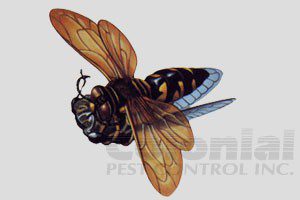
Cicada Killers – Like hornets, cicada killers are sure to ruin many-a-barbecue, especially if the kids get a hold of them. The females will burrow into foundation plantings, along walkways or right in your lawn. The burrow is decorated with lovely corpses of spiders and insects the cicada killer plans to feast on. They’re generally solitary creatures, until your exploring kids get into the burrow, and get a hand full of fury. A related pest is the mud dauber. While the cicada killer is yellow and black and about an inch-and-a-half long, the mud dauber is black and metallic blue and a bit smaller. They’ll construct their burrow with mud in attics, garages or the sides of buildings. Give us a ring if you’re experiencing problems with either kind.
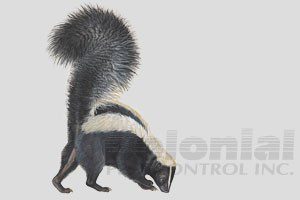
Skunks – There’s no less-desired house guest than a skunk. The skunk’s defensive maneuver is feared from coast to coast, and for good reason. After victims are hit with a bit of his foul-smelling secretion, the stench can linger for days. Even their predators in the wild often won’t take their chances. There’s really no way to prepare for a skunk spraying, so call Colonial immediately if you’ve noticed more than the occasional passerby skunk.
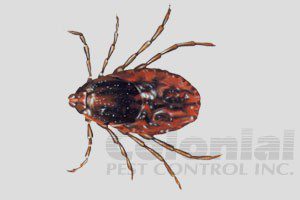
Brown dog ticks – Even though these guys won’t cause problems for humans aside from the wayward bite, they’ll wreak havoc on the itch-response centers of your pooch. These ticks are unique in that they can readily form an infestation in a kennel or your home. Pest control is not only for the health and happiness of humans, but pets, too.
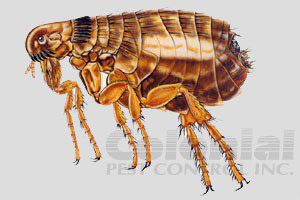
Fleas – One bug that can cause problems for man’s best friend and dog’s best friend is the mighty flea. These insects can produce a new generation cycle in 20 days, which creates a very high volume of these itch-inducers very quickly. A veterinarian must treat pets, but Colonial can completely cleanse that infested house of yours. Your dogs won’t be the only things saved, either. Fleas will bite humans as well.
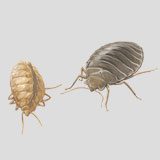
Bed bugs – Speaking of bites… bed bugs are notorious for biting us in our sleep, leaving irritated, red bumps behind, night after night. The good news is, Colonial Pest Control uses a comprehensive “seek-and-destroy” approach to eradicate the nuisance. You may have heard that bed bugs are nearly impossible to get rid of, but with two visits spaced two weeks apart, we will destroy the adults, nymphs, and eggs thoroughly. Those bed bugs will pay homage to Paul Revere himself as they go riding through your sheets at midnight yelling, “Colonial Pest Control is coming!”
Call us at 1-800-525-8084 right now for a FREE quote!
